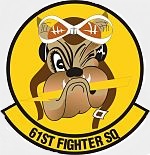Hobby Master HA8453 USAAF Republic P-47D Thunderbolt Fighter - 42-75510, Lt. Col. Francis Gabreski, 61st Fighter Squadron "Top Dogs", Halesworth, England, January 1944 (1:48 Scale)
"Why should we have a navy at all? There are no enemies for it to fight except apparently the Army Air Force."
- General Carl Spaatz, Commander of the US 8th Army Air Force, after WWII
 Nicknamed the "Jug" for its bulky shape, the Republic P-47 Thunderbolt was considered a monster of a machine. Despite its size, the Thunderbolt proved to be a fast and maneuverable warbird able to hold its own in combat. In fact, when Allied pilots climbed aboard a P-47, they knew the were in control of a fighting machine with enormous power. More importantly, they knew that if their aircraft was hit but gunfire, they had an excellent chance of making it home.
Nicknamed the "Jug" for its bulky shape, the Republic P-47 Thunderbolt was considered a monster of a machine. Despite its size, the Thunderbolt proved to be a fast and maneuverable warbird able to hold its own in combat. In fact, when Allied pilots climbed aboard a P-47, they knew the were in control of a fighting machine with enormous power. More importantly, they knew that if their aircraft was hit but gunfire, they had an excellent chance of making it home.
Refinements to the Thunderbolt continued throughout its career, leading to the P-47D, which was the most produced version with 12,558 built. The "D" model actually consisted of a series of evolving production blocks, the last of which were visibly different from the first.
The first P-47Ds were actually the same as P-47Cs. Republic could not produce Thunderbolts fast enough at its Farmingdale plant on Long Island, so a new plant was built at Evansville, Indiana. The Evansville plant first built a total of 110 P-47D-1-RAs, which were completely identical to P-47C-2s. Farmingdale aircraft were identified by the -RE suffix after the block number, while Evansville aircraft were given the -RA suffix.
The P-47D-1 through P-47D-6, the P-47D-10, and the P-47D-11 successively incorporated changes such as the addition of more engine cooling flaps around the back of the cowl to reduce the engine overheating problems that had been seen in the field. Engines and engine subsystems saw refinement, (the P-47D-10 introduced the R-2800-63, replacing the R-2800-21 seen in previous P-47s) as did the fuel, oil and hydraulic systems. Additional armor protection was also added for the pilot.
The P-47D-15 was produced in response to requests by combat units for increased range. "Wet" (equipped with fuel plumbing) underwing pylons were introduced to allow a bomb or drop tank pressurized by vented exhaust air to be carried under each wing, in addition to the belly tank.
Pictured here is a 1:48 scale replica of a P-47D Thunderbolt fighter that was piloted by Col. Francis Gabreski, who was attached to the 61st Fighter Squadron, then deployed to Halesworth, England, during January 1944.
Sold Out!
Dimensions:
Wingspan: 10-inches
Length: 8-3/4-inches
Release Date: October 2016
 Historical Account: "Pride of Poland" - By the time of his retirement from active Air Force service in 1967, Francis S. 'Gabby' Gabreski had flown more combat missions than any other American pilot. This highly decorated Polish-American pilot flew in both WWII and the Korean War, in planes as diverse as the Spitfire Mark IX, the P-47D Thunderbolt, and the F-86 Sabre.
Historical Account: "Pride of Poland" - By the time of his retirement from active Air Force service in 1967, Francis S. 'Gabby' Gabreski had flown more combat missions than any other American pilot. This highly decorated Polish-American pilot flew in both WWII and the Korean War, in planes as diverse as the Spitfire Mark IX, the P-47D Thunderbolt, and the F-86 Sabre.
This model fighter aircraft is resplendent in the markings of the USAAF's famous 61st Fighter Squadron of the 56th Fighter Group, with such delicate touches as a red-striped spinner. This incredibly detailed scale model shows fifteen German victory marks on the fuselage. In fact, 'Gabby' was to reach thirty-one victories (28 aerial, and 3 on the ground) before he was shot down on 20 July1944, and forced to spend the rest of the war in a German POW camp. At the time this made him the highest scoring ace of the war, though several others were to surpass his tally by the end of WWII. Later, he also added another 6.5 victories during the Korean War.


